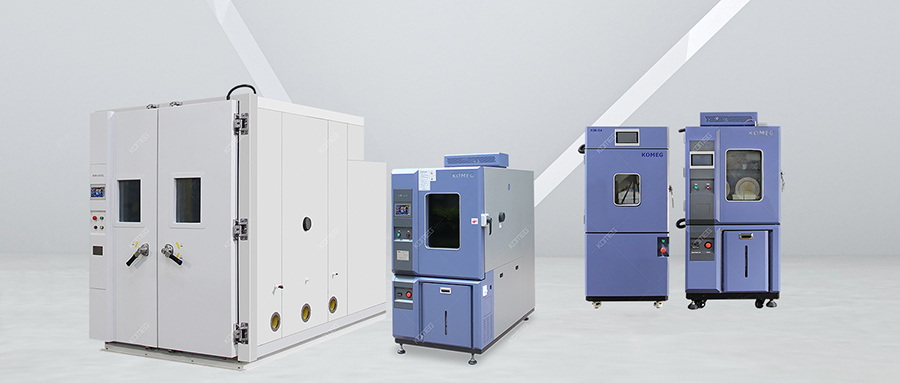Humid and hot environments generally exist in the entire life cycle of electronic products during transportation, storage, and use. Under the influence of humid and hot environments, insulating materials and metals in electronic products will absorb water vapor, resulting in product degradation. At the same time, under the joint action of humidity, temperature and electrical stress, electrochemical reactions and metal corrosion will be caused, resulting in a decrease in the insulation resistance of electronic equipment, an increase in leakage, and in severe cases, arcing and breakdown circuit damage.
On the one hand, the damp heat test can simulate the influence of the damp and hot environment in actual use on the product, on the other hand, it can also identify the moisture resistance of the product and evaluate the safety and reliability of the product under high temperature and high humidity conditions.
Purpose of damp heat test:
There are mainly five physical phenomena in the damp heat test, namely adsorption, condensation, diffusion, absorption and respiration.
Adsorption: gas molecules (water vapor molecules in the hygrothermal test) may collide with the surface of a solid substance (sample) when moving in space, when a certain number of molecules "stay" on the solid surface at a concentration higher than its concentration in space, That is, condensation occurs, and the phenomenon of this gas "staying" on the surface of the sample is called adsorption. Therefore, adsorption can also be said to be an intermediate process of gas condensation and evaporation on the sample surface.
Condensation: To put it bluntly, it is also the adsorption phenomenon of water molecules on the sample, but it is produced when the test temperature rises. In the heating stage, when the surface temperature of the sample is lower than the dew point temperature of the surrounding air, the water vapor will condense into liquid on the surface of the sample to form water droplets. In the heating stage of the alternating damp heat test, due to the thermal inertia of the sample, its temperature rise lags behind the temperature of the test chamber. Thus, condensation occurs.
The amount of condensation on the surface depends on the heat capacity of the sample itself, as well as the heating rate and relative humidity during the heating stage. In addition, condensation will also appear on the inner wall of the closed enclosure during the cooling stage of the alternating damp heat test.
Diffusion: A physical phenomenon of molecular motion. In the process of diffusion, molecules always move from places of high concentration to places of low concentration. During the damp heat test, the diffusion speed of water vapor in the air to the interior of the material with a lower concentration can be expressed by Fick's law. Therefore, the moisture intrusion caused by diffusion in the damp heat test depends not only on the excellent humidity and temperature in the test conditions, but also on the material of the sample.
Absorption (also known as circulation): refers to the mixing of water vapor and air into the interior of the material through the gap of the material, which is formed by three physical processes of diffusion, penetration or capillary condensation. Diffusion and penetration are not only related to the humidity (directly affecting the water vapor pressure) and temperature in the test conditions, but also closely related to the diffusion or permeability coefficient of the material, that is to say, to the material of the sample.
Respiration: For equipment with a closed shell, if there is a cavity with a large volume inside, when the test temperature changes, the air pressure in the cavity will change accordingly, and the exchange of air inside and outside the cavity due to this pressure change is Respiration.
The tidal volume of this respiration into the cavity is not only related to the humidity in the air, but also the temperature change rate and temperature change range of the test conditions are also indispensable.

Test principle:
1. Constant damp heat test
The constant damp heat test is the damp heat test in which the temperature and humidity test conditions do not change with time. The moisture effect of the product is mainly caused by the three physical phenomena of water vapor adsorption, absorption and diffusion. The constant damp heat test method can be selected when the ambient temperature of the testing place where the product is used does not change much and condensation does not occur on the product surface.
The simultaneous action of high temperature and high humidity will accelerate the corrosion of metal parts and the aging of insulating materials. For semiconductor devices, if water vapor penetrates into the die, it will also cause changes in electrical parameters. Especially at the bond or connection of two different metal materials, the infiltration of water vapor will produce an electrochemical reaction, which greatly accelerates the corrosion rate.
In a hot and humid environment, the electroplating layer of the tube shell may peel off, and the outer lead may also be rusted or broken. Therefore, the environmental conditions of high temperature and high humidity are one of the important tests for evaluating the stability and reliability of devices.
2. Alternating damp heat test
Alternating damp heat test method, that is, a damp heat test in which the temperature and humidity conditions periodically fluctuate between high temperature and high humidity and low temperature and high humidity within 24 hours.
When the test sample is under alternating high-humidity and high-temperature conditions, water vapor is sucked into the device through diffusion, thermal movement, respiration and capillary phenomena by virtue of temperature. On the one hand, its intake is related to temperature, absolute humidity, and time (the higher the temperature, the greater the kinetic energy of water molecules, and the easier it is for water molecules to enter the interior of the device. The greater the absolute humidity, the more water molecules are contained, and the water molecules penetrate into the interior of the device more likely).
On the other hand, it is related to the temperature change rate and temperature difference (the temperature change rate determines the number of "breathing" per unit time; the temperature difference determines the degree of "breathing"). The alternating action of high temperature and high humidity at the same time will accelerate the corrosion of metal parts and the aging of insulating materials.
The alternating damp heat test is different from the constant damp heat test. It uses temperature cycling to improve the test effect. The purpose is to provide an alternating process of condensation and drying, so that the water vapor entering the sealed enclosure can have a "breathing" effect, thereby accelerating the corrosion process. At high temperatures, the effect of moisture will be more pronounced.
The test included a low-temperature subcycle, which accelerated degradation that would not otherwise be apparent. This degradation can be revealed by measuring the electrical properties (breakdown voltage and insulation resistance) or by performing a sealing test. If necessary, the alternating damp heat test can also apply a certain electrical load to some components to determine the electrochemical corrosion resistance of current-carrying components, especially thin wires and contacts.

How to choose the type of damp heat test?
1. Select the damp heat test method according to the characteristics of the sample itself. The test sample is solid or insulating, and the constant damp heat test is usually used to test the electrical or insulating properties of the product in a humid atmosphere; if the test sample is sealed or hollow, the alternating damp heat test is often used because the sample will Thermal expansion and contraction under the action of thermal stress cause the product to be damp.
2. Select the damp heat test method according to the moisture mechanism of the sample. If the sample is damp after absorbing or absorbing moisture, the constant damp heat test should generally be used; if the sample is condensed or through respiration to strengthen the influence of humidity on the product, the alternating damp heat test should be used.
Laboratory equipment:
1. The equipment for damp heat test, constant damp heat test and alternating damp heat test are: damp heat test chamber, constant damp heat test chamber and high and low temperature damp heat test chamber.
2. See G82423.22, GB2423.34, GJBl50.9, etc. for the relevant implementation test standards.
3. There are four common ways to make the test chamber produce humid conditions: water volatilization humidification, bubble humidification, spray humidification and steam humidification.






